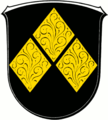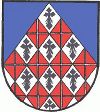Diamond (heraldry)
The rhombus is a frequently used style element in coats of arms , it is a herald image and is often found in Bavaria .
Blazon and variants

As a heraldic form, the concept of the geometric diamond (rhombus) is differentiated:
- A pointed square to mediocre rhombus is a rhombus ( French losange , English lozenge ), flat roughness , roughened ( lozengy )
- A sleek diamond in the coat of arms is a spindle (also there are loose, Wachel or pointed diamond , fr., Eng. Fusil ) emblazoned, flat spindled fusilly , medium slender forms of Rautung be Wecke (aroused) called
- The square rhombus is specifically called an edge cube , flat diagonally diced .
In earlier times of heraldry, the distinction between rhombus and wake was not made, this only became necessary with the increase in the number of coats of arms. The use of language for old noble coats of arms cannot be changed so quickly. So the Bavarian coat of arms remains a roughened , although it would have to be called awakened . Otherwise, as always in heraldry, the blazon, i.e. the verbal description, is binding, not the concrete graphic representation. The following rules apply analogously to all forms of diamonds.
The long diagonal standing (in the pole ) is the normal form, otherwise the diamond is called lying . The pattern is called roughened (awakened) .
If one of the sides of a diamond run parallel to the upper edge of the shield and the other diagonally, the shield is roughened in bars or with divisions ( diagonally ) to the right or to the left , depending on the orientation of the diagonal lines. In the case of lines parallel to the side edge of the shield, it is said to be roughened by piles or with splits obliquely left / obliquely right , depending on the direction of the diagonal lines. If the diamonds are inclined - no side parallelism, depending on the orientation of the longitudinal axis of the individual diamonds, it is referred to as a right or left oblique shield or field (head, base, etc.) or a figure. The position of the individual rolls through their longitudinal axis determines the alignment.
Several diamonds that touch each other in a row at the tips are called abutting , if they touch each other vertically, they abut each other in stacks ( accolés , conjoined in fess / pale ). If they touch each other across the board, one speaks of roughened ( losangé , lozengy ; not diagonal but means shaft ).
The diamond can be divided or split like a heraldic shield. Like any other heraldic figure, the position of several diamonds, for example in a three-pass, 2: 1, 1: 2, can be placed after the figure (sloping bar) and arranged in the shield in a pole or bar .
The diamond can also be found in the upper coat of arms .
Variants are:
- Is a diamond with a board surrounded, this is the window diamond . The appearance resembles the lack of the inner part, i.e. a diamond-shaped hole. Those with a round hole are called pierced , the shield color must be visible in the breakthrough. These are generally emblazoned as openwork (also with other shapes of the holes; French / English heraldry has its own vocabulary: macle / mascle for diamonds with a diamond-shaped hole, comprehensive English masculy , and rustre for those with a round hole).
- A diamond with the cross on its diagonal is called a polished diamond .
- In the case of a faceted diamond , also called a gemstone , there is a line parallel to the diamond edge at a small circumferential distance and the corners of this figure are connected to the actual outer edge with short lines. A cross of the diagonals can also be present.
- Another special form is with nail heads , diamonds at a distance with small points in the intersection lines of the spaces. They represent a shield fitting.
- Rectangular diamonds, small and several as a heraldic figure, are also emblazoned with cards (like little plates for 'shield').
The cut diamond and the faceted diamond create the impression of a precious stone.
- Special forms
Three spindles in front ( Pfaffing DE)
Pierced diamond
( Courris FR)Cut diamonds
( Admont AT)Damascus diamonds ( Eckelshausen )
The continuous diamond is a diamond that is placed at all four corners on the edge of the shield: It is not a herald image, but a coat of arms (French / English as vêtu / vetu shield emblazoned).
Diamond sign has two different meanings:
- The diamond shield is a special shield shape, often referred to as a lady's shield.
- Second, shields with a predominantly diamond or wake image are named as herald image in the shield. An example is the coat of arms of the district of Starnberg .
For the different types of cross that can be formed from the diamond, see diamond cross .
Examples
- coat of arms
7 diamonds ( Fronhausen , for 7 districts)
"Divided ... on top of a flat green Dreiberg a ... red lion ..., below seven red diamonds (4: 3)." ( Virneburg )
A point of diamonds made of ermine and red, silver faceted diamonds ( Hofkirchen bH AT)
Roughed red and white ( Stettfurt , CH)
- Flags
Signal Foxtrot in flag alphabet
Web links
- Diamond (Heraldry) in the Heraldry Wiki
Individual evidence
- ↑ No. 187 and No. 188 . In: Heraldic Atlas , heraldica.org
- ^ A b Walter Leonhard : The great book of heraldic art . Munich 1978 (licensed edition Augsburg 2000), ISBN 3-8289-0768-7 , p. 168
- ^ A b c Maximilian Gritzner : Principles of heraldic art, combined with a manual of heraldic terminology. Bauer & Raspe, Nuremberg 1889–1890 (facsimile edition 2012: ISBN 3-226-00671-1 ), p. 59, illustration plate 9, no. 92
- ↑ Fig. See No. 486 . In: Heraldic Atlas , heraldica.org
- ↑ diamond . In: Wappenkunde translator , heraldica.org


















